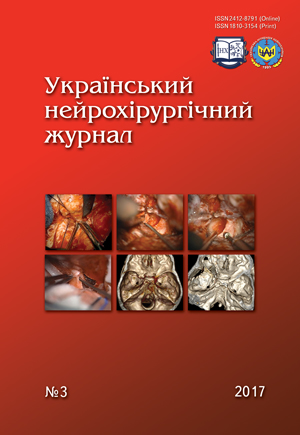Reconstruction of complex soft tissues defects of the cranial vault in neurooncological patients
DOI:
https://doi.org/10.25305/unj.112099Keywords:
complex defects of the soft tissues, cranial vault, surgical treatment, musculocutaneous flapAbstract
Objective. To improve the results of surgical treatment of neurooncological patients with complex defects of the soft tissues of the cranial vault using trapezius musculocutaneous flaps (TMF).
Маterials and methods. During the period from September 2016 to March 2017, 3 patients with complex defects of the soft tissues of the cranial vault were observed after removal of large and giant advaced extra-intracranial malignant tumors. Reconstruction of complex soft tissue defects was performed using horizontal (2) and vertical (1) trapezius musculocutaneous flaps.
Results. The location and direction of the dominant trapezius musculocutaneous vessels determines two possible variants of microvascular flaps formation: a horizontal flap with the inclusion of a horizontal muscle part on the basis of the superficial feeding branch of the transverse cervical artery and a vertical flap with the inclusion of a vertical part of the muscle on the basis of the deep feeding branch of the transverse cervical artery. The choice of reconstruction type depends on the defect anatomical location and the volume of necessary tissues.
Conclusions. In patients with advanced stages of cranial carcinoma, the operation of choice for the plasty of complex defects in the soft tissues of the cranial vault is the use of regional trapezius musculoskeletal flaps. The type, shape and necessary volume of the tissues depends on the size and location of the complex defect. The use of a horizontal trapezius musculocutaneous flap is recommended for the plasty of the temporoparietal region of the head, and a vertical trapezoidal musculocutaneous flap should be used to close the occipital parietal defect.
References
1. Protsyk V., Kravets O., Trembach O., Korobko Y, Mosin O., Chichula R. [Reconstructive restorative operations in advanced head and neck cancer surgery]. Klinicheskaya onkologiya. 2011;1(1):62-6. Russian. Available from: http://www.clinicaloncology.com.ua/article/481/.
2. Can A, Orgill DP, Dietmar Ulrich JO, Mureau MA. The myocutaneous trapezius flap revisited: a treatment algorithm for optimal surgical outcomes based on 43 flap reconstructions. J Plast Reconstr Aesthet Surg. 2014 Dec;67(12):1669-79. [CrossRef] [PubMed]
3. Tan KC, Tan BK. Extended lower trapezius island myocutaneous flap: a fasciomyocutaneous flap based on the dorsal scapular artery. Plast Reconstr Surg. 2000 Apr;105(5):1758-63. [CrossRef] [PubMed]
4. Yoon SK, Song SH, Kang N, Yoon YH, Koo BS, Oh SH. Reconstruction of the head and neck region using lower trapezius musculocutaneous flaps. Arch Plast Surg. 2012 Nov;39(6):626-30. [CrossRef] [PubMed] [PubMed Central]
5. Ou KL, Dai YH, Wang HJ, Chen TM, Dai NT, Chang SC, Deng SC, Tzeng YS, Wang CH, Chen SG. The lower trapezius musculocutaneous flap for head and neck reconstruction: two decades of clinical experience. Ann Plast Surg. 2013 Dec;71 Suppl 1:S48-54. [CrossRef] [PubMed]
6. Yang HJ, Lee DH, Kim YW, Lee SG, Cheon YW. The Trapezius Muscle Flap: A Viable Alternative for Posterior Scalp and Neck Reconstruction. Arch Plast Surg. 2016 Nov;43(6):529-35. [CrossRef] [PubMed] [PubMed Central]
7. Mathes SJ, Nahai F. Classification of the vascular anatomy of muscles: experimental and clinical correlation. Plast Reconstr Surg. 1981 Feb;67(2):177-87. [CrossRef] [PubMed]
8. Tan BK, Wong CH, Chen HC. Anatomic variations in head and neck reconstruction. Semin Plast Surg. 2010 May;24(2):155-70. [CrossRef] [PubMed] [PubMed Central]
Downloads
Published
How to Cite
Issue
Section
License
Copyright (c) 2017 Мichail S. Kvasha, Аlexandr A. Zhernov, Vitalii Y. Molotkovets, Elena M. Kvasha, Oleksii V. Ukrainets, Andrii V. Dashchakovskyi, Stanislav S. Mosiychuk

This work is licensed under a Creative Commons Attribution 4.0 International License.
Ukrainian Neurosurgical Journal abides by the CREATIVE COMMONS copyright rights and permissions for open access journals.
Authors, who are published in this Journal, agree to the following conditions:
1. The authors reserve the right to authorship of the work and pass the first publication right of this work to the Journal under the terms of Creative Commons Attribution License, which allows others to freely distribute the published research with the obligatory reference to the authors of the original work and the first publication of the work in this Journal.
2. The authors have the right to conclude separate supplement agreements that relate to non-exclusive work distribution in the form of which it has been published by the Journal (for example, to upload the work to the online storage of the Journal or publish it as part of a monograph), provided that the reference to the first publication of the work in this Journal is included.









